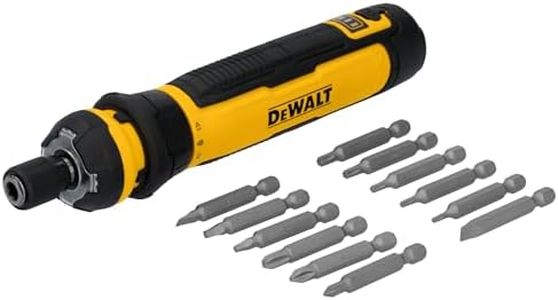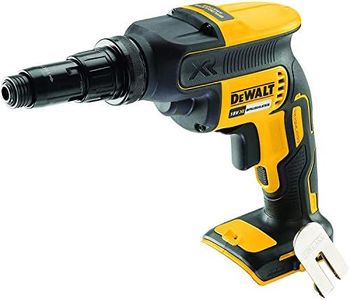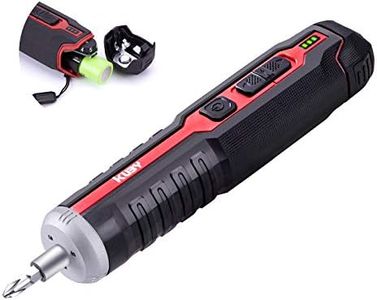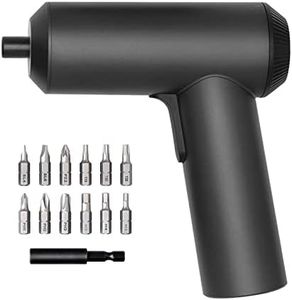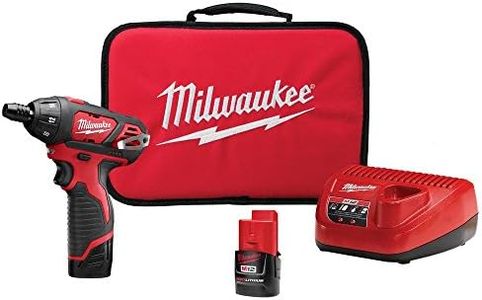We Use CookiesWe use cookies to enhance the security, performance,
functionality and for analytical and promotional activities. By continuing to browse this site you
are agreeing to our privacy policy
10 Best Cordless Screwdrivers
From leading brands and best sellers available on the web.By clicking on a link to a third party's website, log data is shared with that third party.
Buying Guide for the Best Cordless Screwdrivers
Choosing a cordless screwdriver can make a big difference in how efficiently and comfortably you handle DIY projects or household repairs. The right tool should match your typical tasks, whether it’s assembling furniture, fixing appliances, or doing small renovations. It’s important to look for a balanced combination of power, ease of use, battery life, and ergonomics. Understanding what key features mean and how they fit your needs will help ensure you make a satisfying and long-lasting choice.Battery VoltageBattery voltage refers to the amount of power the cordless screwdriver can deliver. Higher voltage can provide more torque, allowing the tool to drive screws into tougher materials or handle larger screws. For light tasks or small assembly projects, a lower voltage (around 3.6V to 6V) is usually enough. For more demanding work, like driving screws into hardwood or tougher materials, higher voltages (7V to 10V or more) are beneficial. To pick the right battery voltage, consider the hardest material you’ll likely face and how often you plan to use the tool for extended periods.
TorqueTorque measures the force with which the screwdriver can turn a screw. More torque means more turning power, which is important for driving screws into hard surfaces or larger screws. Entry-level models offer less torque, which is fine for lighter tasks like electronics or softwood. Medium torque levels suit furniture assembly and most household tasks, while higher torque is necessary for heavier duty or construction-related jobs. Think about whether you’ll mostly be working with lighter materials or if you expect to tackle tougher projects, and choose accordingly.
Battery Type and CapacityCordless screwdrivers usually use either lithium-ion (Li-ion) or nickel-cadmium (NiCd) batteries. Li-ion batteries are more common now, offering longer life, lighter weight, and no memory effect, making them preferable for most users. Battery capacity, measured in amp-hours (Ah), affects how long you can use the screwdriver before needing to recharge. Smaller capacities are fine for occasional or short tasks, while larger capacities help if you need to use the tool for long periods or don’t want to stop for frequent recharging. Choose based on how often and how long you’ll use your screwdriver in a typical session.
Speed (RPM)Speed, measured in revolutions per minute (RPM), indicates how quickly the screwdriver rotates. Lower speeds are suitable for delicate tasks, while higher speeds can drive screws faster but may be harder to control for fine work. Some screwdrivers allow you to adjust speed, which adds versatility. If you mostly do precise, slower work, look for lower speeds with good control. If you need to get through lots of screws quickly, a faster option might suit you better.
Clutch SettingsA clutch setting lets you choose how much torque is applied before the screwdriver stops turning, preventing over-tightening or damaging materials. More clutch settings offer finer control and are especially helpful when working with different materials or screw sizes. If you plan to use your screwdriver for varied tasks—like assembling furniture, hanging shelves, or working with delicate items—a model with multiple clutch settings is a smart pick. If your work is mostly repetitive and similar, fewer settings may suffice.
Size and WeightThe physical size and weight of a cordless screwdriver affect how comfortable and easy it is to use, especially during extended tasks or in tight spaces. Compact and lighter tools are easier to maneuver and less tiring to use, making them suitable for overhead work or in confined areas. Larger models may offer more power but can be bulkier and heavier. Consider how and where you’ll use your screwdriver most often: if you expect to use it in small spaces or for long periods, prioritize ergonomics and manageable weight.
Bit Holder TypeThe bit holder determines how you insert and hold screwdriver bits. Keyless chucks or magnetic holders offer quick and easy bit changes and are ideal for frequent switching between different types of bits. Hex shanks provide a more solid grip if you need more stability or are driving tougher screws. If you plan to swap bits regularly or need convenience, look for quick-change or magnetic holders. If you’ll use one type of bit most of the time, holder style may be less important.




